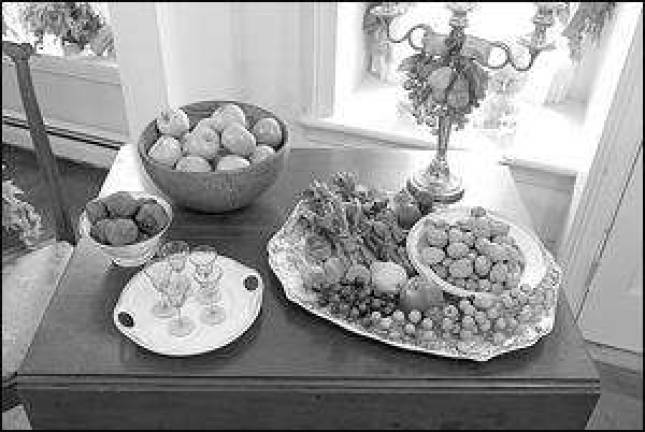Before Milwaukee had its beer, Warwick had its applejack

Editor’s note: The Historical Society of the Town of Warwick will host Tavern Night at Baird’s Tavern, featuring beverages and a sampling of food typical of colonial times on Saturday, Feb. 10, from 7 to 9 p.m. The following piece by historian Richard W. Hull traces the origins of the brew that made Warwick famous. By Richard W. Hull Warwick - In colonial times “Warwick” conjured up visions of boisterous taverns and powerful applejack. Indeed, applejack was king of beverages in our valleys and it was produced in numerous small farmer-owned distilleries near powerful springs of pure water scattered around the community. The term derives from “jacking” which referred to the distillation process. From about 1750 to the late 1800s, it was one of our community’s largest and most profitable enterprises. Apple orchards always abounded even in the Indian era. But without refrigeration, apples perished quickly and farmers soon discovered that more money could be made in distilling most of their apple harvest into brandy of high alcoholic content, often in excess of 40 percent. It was a popular and cheap staple in the dozens of local taverns, though by the Revolutionary War significant quantities were exported to New York City taverns and even to distributors overseas. Locally, this powerful brew was not only for social consumption but had medicinal uses in cleansing wounds and anesthetizing patients undergoing surgery. The apple brandy was sometimes diluted with grain spirits to raise its alcoholic content. Warwick applejack had a wide reputation for its special slightly sweet apple flavor and compelling aroma. In some homes it was even served in small quantity to young family members as an appetizer at special dinner occasions or to mitigate the effects of winter colds and body aches. The distillation process was considered an art and Warwick was not short of master distillers. Aged for two years One of the earliest and most enduring of Warwick’s distilleries was the so-called Sayer distillery on the road to Bellvale. It was chartered by the colonial government of King George III and produced enormous volumes of apple brandy. Cider, after it fermented into fresh distillate, was left in huge oak casks for at least two years before being bottled. In its heyday in 1915, the famed Sayer distillery, one of the oldest and largest in America, annually produced more than 11,000 gallons of applejack from 32,600 bushels of locally grown apples. When Washington and his troops visited Baird’s Tavern, there were an estimated dozen licensed distilleries in town. Baird probably bought much of his applejack from the Sayer distillery, which came to be owned by his relatives. By 1824 there were at least 26 distilleries in town supplying more than two dozen local hotels, inns and taverns. By the Civil War there were more than 30. Whiskey tax In the years 1871-73 the applejack crop of Orange County paid more than a third of all whiskey tax in New York State. Farmers and tavern owners alike grew rich on the distillation and marketing of local spirits. After the Civil War, the consumption of beer gradually eroded the distillery business. It was also hurt by a stiff new federal tax imposed on liquor sales. In addition, the anti-alcohol Women’s Christian Temperance Union was organized in 1874 and by 1890 it had a strong chapter in Warwick with support from all churches, especially the Methodists. By 1900 it had joined forces with the Anti-Saloon League, another national organization. Despite their protestations, the taverns continued to flourish. Outside the church they were the major center for socializing. Finally in 1919, Congress outlawed the manufacture, transportation and sale of all alcoholic beverages. Still, Prohibition was not easy to enforce in Warwick, and though most distilleries had gone out of business by 1919 the Sayer distillery remained obstinate, arguing that it had received its charter long before the establishment of the U.S. Congress. FBI raid Inevitably, bootlegging led to crime and violence. Finally, in the early 1930s in a spectacular FBI raid that received national press coverage the famous Warwick enterprise was shut down after nearly two hundred years of operation. Though Prohibition was repealed by Congress in 1933, the applejack industry never revived. Yet in the basements of many old-timers in Warwick were stashes of applejack and this author was treated to some as recently as the late 1970s. Since the 1920s, applejack production has been a home-grown hobby, and it was not until this century that commercial apple brandy-making began to return to the region. One might say that Warwick has come full circle. The particulars The Historical Society of the Town of Warwick will host Tavern Night at Baird’s Tavern, featuring beverages and a sampling of tavern food typical of colonial times on Saturday, Feb. 10, from 7 to 9 p.m. The tavern is located at 105 Main St. in Warwick. Admission at the door will be $20 per person. Proceeds used for the society’s new education center. For more information call 986-3236 or check out the society’s Web site at: www.warwickhistoricalsociety.org.